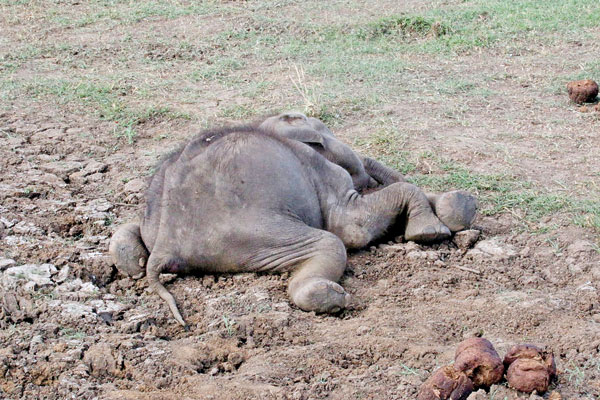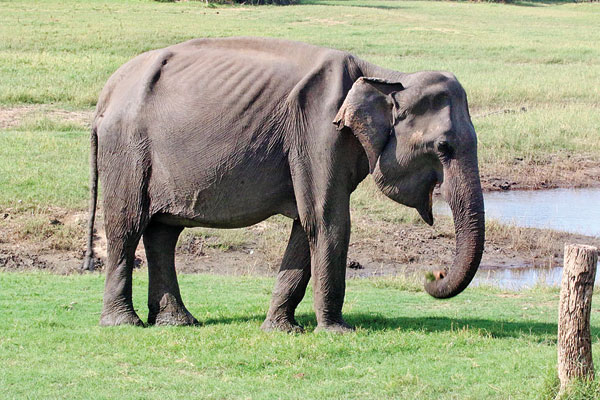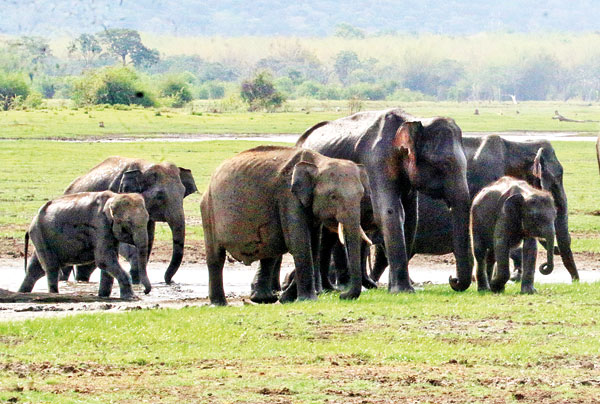News
The bell tolls for the ‘Gathering’
View(s):Ghostly creatures haunt Minneriya-Kaudulla where majestic elephants roamed before
By Kumudini Hettiarachchi
Wild elephants, especially babies and juveniles, in this area are dying! No it is not speculation, the Sunday Times learnt on contacting the Centre for Conservation and Research (CCR) and also the former Director-General of the Department of Wildlife Conservation (DWC), Dr. Sumith Pilapitiya who are looking closely at the plight of wild elephants in Sri Lanka.

Tragically, the baby is dead on the Minneriya grasslands, a very young life snuffed out where others have gambolled happily before the unseasonal water releases began
A dead elephant calf on the grasslands of the Minneriya tank had been spotted on June 30, this year, by Dr. Pilapitiya who is also an elephant researcher. Describing it as “heartrending”, he says that the calf had died a few hours before and he had immediately informed the DWC.
According to him the postmortem on the calf had revealed that it died of malnutrition and starvation.
“This is a strong validation of the predictions of elephant experts that unseasonal filling of water into the Minneriya and Kaudulla tanks would lead to the starvation of wild elephants in this area,” says Dr. Pilapitiya, pointing out that no one would know the numbers dying in the jungles.
“Catastrophic,” is how CCR Chairman Dr. Prithiviraj Fernando described the impact on the elephants of the ‘Gathering’ by keeping the Minneriya-Kaudulla tanks filled to the brim during the dry season, going against the usual pattern of water management.
The Sunday Times’ queries to these experts this week followed a panel discussion held by the Wildlife and Nature Protection Society (WNPS) on the ‘Gathering’ on World Elephant Day, which fell on August 12. Among the panellists was the Director of Irrigation, Engineer D. Abeysiriwardena, while the DWC was conspicuous by its absence. The discussion was moderated by Dr. Pilapitiya.
Dr. Fernando said the skeletal elephants in the Minneriya-Kaudulla area can be directly linked to the starvation they are facing by being prevented from feeding on the nutritious, tender grass shoots that spring up on these tank-beds. The grass shoots appear when the water levels recede during the dry season, as the water is let out for the ‘yala’ cultivation.
He explains that an elephant’s health can be assessed from body condition parameters:
By looking at elephants (or people), it is possible to say whether they are emaciated, thin, normal, chubby or obese.
Based on this principle, Dr. Fernando and co-authors had developed a method to score the body condition of elephants, which was published in the journal ‘Gajah’ in 2009.

Oh, where is her baby? The lactating mother without her little one
The scale has scores from 0 to 10, with female and young elephants normally being above 4 and male elephants above 5.
Earlier, before the Moragahakanda project began diverting water to the Minneriya and Kaudulla tanks, data indicated that female and young elephants in the area scored between 5 and 6 and males between 6 and 8.
Next come the chilling facts – 2022 data show that:
The average body condition of male elephants has dropped to 5.
The average body condition of female elephants has dropped drastically to below 2.6 and of juveniles to 2.9.
Dr. Fernando laments that there is severe malnourishment among these elephants and that it is a death knell for juveniles.
“Some juveniles would have already died and others will continue to die,” he says, underscoring that even if normal patterns are restored, it will take years for the herds to recover from this disastrous situation. If Sri Lanka continues to send water to keep the Minneriya and Kaudulla tanks filled to the brim in the dry season, there will be no recovery and the much-touted ‘Gathering’ would become just a memory of a bygone era.

A small group of elephants including juvenile tuskers with protruding ribs and bones – testimony to starvation. Pix courtesy of Dr. Sumith Pilapitiya
Dr. Pilapitiya, meanwhile, recalls another harrowing image he saw at Minneriya just a month or two ago. It was a female, unusually all alone, whose body condition was also bad. It was obvious that she had been suckling a baby for her nipples were white. Normally, when female elephants are not feeding their babies, the nipples are black.
“But her baby was missing. We waited and waited for the baby to return to its mother but it did not. The baby never came, with the most likely scenario being that it had died,” he said with emotion.
Another observation that Dr. Pilapitiya has made in the Minneriya-Kaudulla area is that the herds of females, babies and juveniles are diminishing in number. This happens when there is a lack of fodder and the herds break up, as larger the herd, the more difficult it is to find food.
Many other experts including Dr. Fernando and Dr. Pilapitiya are categorical that the stocking of large volumes of water in these two tanks in the dry season should be “stopped forthwith” to save these elephants from a slow and inevitable death.
“It is obvious that what happened in 2021 should never happen again,” said Dr. Fernando, pointing out that is unnecessary, because the water stocked during the dry season cannot be used. The authorities would be compelled to release it by opening the spill gates when the north-east monsoon rains come in the wet season. This is exactly what happened in 2021-2022. The spill gates had to be opened and the water was released at the end of the year as widely reported in the media. So nothing was gained by stocking that water. But it caused great harm to the ‘Gathering’.
He added that this issue was identified in the Asian Development Bank funded Upper Elahera Canal Project – Wildlife Management Plan in 2017. A condition laid down in project approval was the development of a ‘reservoir water management regime’ to maximize the grasslands in the dry season. This appears not to have been done.

The majestic wild elephants of Minneriya-Kaudulla in better times before the offseason filling of the tanks. (Courtesy of CCR)
The best way to say that you found the home of your dreams is by finding it on Hitad.lk. We have listings for apartments for sale or rent in Sri Lanka, no matter what locale you're looking for! Whether you live in Colombo, Galle, Kandy, Matara, Jaffna and more - we've got them all!

